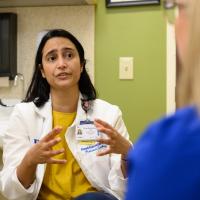




Wild at Heart
“The ultrasound tech was going over and over the same spot,” said Jennifer. “We were trying to process it, but we were just in shock. It was so nerve-wracking to know something was wrong with his heart but we didn’t know exactly what yet. You go through every possibility in your head and we just hoped and prayed that it was something they could fix—that he would be okay.”
When Jennifer and Michael Brinegar found out they were expecting their second child, Jeremiah, they were over-the-moon thrilled. The Lexington natives brought along big brother Bennett to the baby’s 20-week anatomy scan—but that excitement was slowly replaced with dread as the Brinegars realized something wasn’t right with their baby’s heart.
Dr. Preeti Ramachandran, a pediatric cardiologist at Kentucky Children’s Hospital’s Congenital Heart Clinic, met with the Brinegars to review Jeremiah's test results. She confirmed his diagnosis: D-Transposition of the Great Arteries (d-TGA). Babies with this congenital heart defect are born with their aorta and pulmonary artery transposed, affecting circulation and the body’s ability to get oxygenated blood. Heart surgery is required for d-TGA babies to help regain the correct circulation in their bodies.
Jennifer had one advantage over other parents receiving a similar diagnosis: she’s a nurse. Her medical background and training kicked in, helping her take control of the nerve-wracking situation by researching everything she could about congenital heart defects.
“I still remember, when I gave Jeremiah’s diagnosis, Jennifer was incredibly calm, incredibly poised,” said Dr. Ramachandran. “I knew the immense stress and anxiety that comes with this, but she responded to it beautifully. Parents always have a lot of questions and they get emotional during this process, but she was extremely composed as we went through all of the details.”
Careful preparations were made for Jeremiah’s arrival. With a due date of New Year’s Day, Dr. Ramachandran wanted to make sure the correct care team was in place, no matter when Jennifer went into labor. “When we expect a baby like Jeremiah to be born, we prepare the OB team, the neonatal intensive care unit (NICU) and cardiac ICU,” says Dr. Ramachandran. “We gave everyone a head’s up so that the moment Jeremiah was born, we would be able to stabilize him and transfer him to the cardiac ICU.”
At Jennifer’s OB appointment right before Christmas, Jeremiah’s heart rate showed concerning dips, so they admitted her for observation and ultimately decided to induce her. Jeremiah was born at 7:03 a.m. on Dec. 22. Jennifer and Michael were able to hold their new son briefly before the care team took him to the PICU.
Within hours of his delivery, Jeremiah underwent a balloon atrial septostomy to help his body mix more oxygenated blood. A special catheter with a balloon attached to its tip was introduced into Jeremiah’s body through a blood vessel in his groin. The balloon was then used to enlarge his foramen ovale—the hole between the left and right atria of his heart—allowing blood from both sides to mix together.






Jennifer and Michael were able to visit Jeremiah shortly after his procedure, and once Jennifer was by her son’s bedside, she rarely left. She felt like a trusted partner in her son’s medical care over the 18 days he was in the hospital. “There was always someone by his side, nurses or a doctor. Whenever decisions needed to be made, everyone collaborated and included me,” said Jennifer. “It’s a very patient-centered and family-oriented aspect of care. No one was making decisions on their own—it was a team effort and a team decision.”
Jeremiah underwent surgery to fix the transposition when he was a few days old. Despite a few complications, he is now a thriving toddler, running around and causing chaos—like constantly climbing in and out of his crib. “Jeremiah has the biggest personality,” said Jennifer. “He’s just like a Sour Patch Kid, you never know if he’s going to come up to you and try to bite you or kiss you. And he’s wild—I thought our oldest was a wild child, but Jeremiah has proved he’s the wild one.”
“It’s such a beautiful transition because when they’re born, they’re so tiny and helpless,” said Dr. Ramachandran. “Now Jeremiah is just like any two-year-old. Unless you saw the scar on the front of his chest, you wouldn’t know it. He looks great and is turning into quite the mischievous two-year-old. He’s one of our congenital heart disease superheroes.”
In addition to being thankful for Jeremiah’s spunky approach to life, Jennifer also found a new career path from her family’s experience. She underwent specialty training to become a cardiac ICU nurse and moved to Jeremiah’s specific unit to work side-by-side with the care team who helped her baby survive—and thrive. “My career path change should be a reflection of the care we received while in the hospital. I am blessed to have this opportunity to work with the best care providers and the toughest group of patients around.”
“This experience brought Jennifer to a new calling in life,” says Dr. Ramachandran. “We’re fortunate to have her as a part of the team because she brings such a unique perspective. She has lived through this and has a child with ACHD. She truly has walked in their shoes.” As for Jeremiah, his sweet grin says it all. He’s wild at heart—and proud of it.








